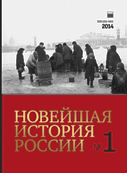Петр Евгеньевич Корнилов (1896–1981). Творческий путь. Восхождение
Piotr Evgenievich Kornilov (1896–1981). His Career Path and Ascent
Author(s): Andrey Aleksandrovich KharshakSubject(s): Fine Arts / Performing Arts
Published by: Издательство Исторического факультета СПбГУ
Keywords: graphic arts department; cataloging; the Russian Museum; the Academy of arts; I. I. Brodskiy; lithography; cards of admission; room of graphic arts; one-person exhibitions; author albums; P. A. Shillingovsky; S. M. Kirov; “Truth”; “Pushkin chronicles"
Summary/Abstract: The period from 1932 till 1941 in Piotr Evgenievich Kornilov’s biography, the beginning of which was published in issues N 2 (04) in 2012 and N 1 (06) in 2013 of The Modern History of Russia, was likely the most intensive and fruitful creative time of his life. His vigorous activity in fields associated with scholarship, education, and museum exhibition allowed him to become a leading historian and expert in the Russian graphic arts. These years were complicated, inasmuch as they marked the beginning of the party’s and state’s active interference in all spheres of artistic life. Artistic associations that had emerged in the first years of Soviet power were closed down. New structures, completely controlled by the party leadership, were organized in their place. Strict measures were taken against formalistic tendencies in art. But despite of all this, the Leningrad graphic arts created works that mark perhaps the high point in the history of book illustration and easel printing. Owing to his positions as head of the Graphic Arts Department of the Russian Museum and head of the Department of Graphic Arts in the All-Russian Academy of Arts, Kornilov aided in the creation of the preconditions necessary for the realization of the creative artistic concepts of a wide range of graphic artists from different schools. A graphic workshop for trainees was revived at the Institute for Painting, Sculpture and Architecture in 1936 under his attentive watch. Thus, Kornilov displayed the all the best qualities of a devoted scholar and practical organizer and played a significant role in the development of Soviet art during the 1930s and after.
Journal: Новейшая история России
- Issue Year: 4/2014
- Issue No: 09
- Page Range: 212-247
- Page Count: 36
- Language: Russian

